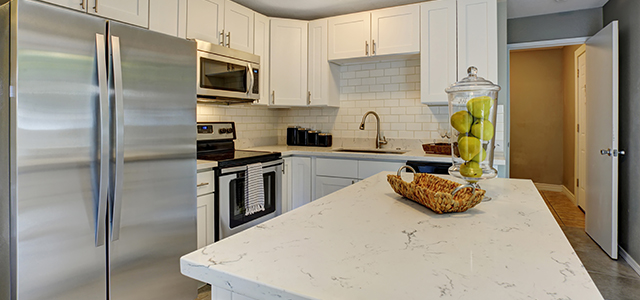If you are considering the addition of quartz or granite into your kitchen or bathroom, you may feel as if you are facing a confusing decision. You have likely heard about all of the benefits of these materials, and perhaps even some of the myths or cons of the materials. With all of this information and opinion out there, making the decision between granite and quartz can be confusing.
In many cases, these materials look quite similar, and you may not even be able to tell the difference until you get close and look at the slab. You cannot even feel the difference between engineered quartz and granite in most cases. Where do the differences come into play? You will only see the differences when you look at the details.
A Quick Look at Granite vs. Engineered Quartz
Most people think that since granite is made in nature and engineered quartz is made in a lab, the natural choice is the better choice. This, however, is not necessarily the case. Though some features of granite are superior to engineered quartz, there are also features of quartz that outperform granite. What does this mean for you? It means it is best to break down the different features of these popular countertop materials and compare them side-by-side. Only then will you know which material might be best for your kitchen or bathroom.
What is Engineered Quartz? What is Granite?
This first thing that you should think about is the basic material in both cases.
Quartz, which many people mistake as the stone, quartz, is actually engineered in a lab. Though natural quartz is used in the making of engineered quartz, so are other materials including resins and dyes. These ingredients are mixed into a slurry and formed into a slab. The result is a slab of material that has many features of natural stone, yet it is not fully natural.
Granite, on the other hand, is quarried directly from the earth, and the color and design is set by Mother Nature. What you see, with granite, is what you get.
The Look of Quartz and Granite
Most people are highly concerned about the look of both granite and quartz. When it comes to quartz, the colors, dimensions and even design are all made in a lab. These are the same through and through, so even if you cut a slab of quartz in half, you will see the same pattern.
Granite, however, may change from slab to slab, even if cut from the same quarry. So, one slab of granite may look gorgeous with stunning color veining, but the next slab cut from the quarry may be very plain, with only a few splashes of color.
Both granite and quartz can be honed to have a glossy look, and both are smooth to the touch.
The Durability of Quartz and Granite
Both quartz and granite are some of the most durable materials on the market for kitchen and bathroom countertop. However, both of these hard materials have a weakness. Quartz, for example, is almost impossible to break or crack. However, it can scorch, so it is extremely important to use care when cooking around quartz countertops. For instance, you must use a trivet when laying hot pots and pans on the surface of a quartz countertop.
Granite, on the other hand, will never scorch. You can place hot pots and pans directly on the stone without worry, but if there is enough pressure applied to granite, it can crack or even break. Though most kitchens would not be used in any way that could break granite, something large or heavy falling onto a granite surface at the right angle could certainly cause a break or crack in the surface.
The Installation of Granite and Quartz
Both granite and quartz are difficult to install, so only a professional should take on this task. Both materials come to the home in premeasured slabs, and the installation team will have to make very precise measurements and cuts to ensure the pieces fit together as they should. Also, after installation, both of these materials will have seams where one slab has been installed against the next. It is extremely difficult to hide the seams, but professional installers have the training and experience to ensure they are as invisible as possible.
These are only a few of the things that you should compare when considering engineered quartz and granite. As you can see, there are many differences between these materials, but also similarities. For instance, both have similar price points, so taking the route of the most affordable option is not necessarily the best way to choose the material. Instead, it is best to look at the different aspects of the material, and find out which material may be better for your home, lifestyle and family.


